Webinars Post
When Rubber Leaves the Road: Investigating Vehicle-Impacted Buildings
May 15, 2024

Imagine a quiet afternoon suddenly interrupted by the loud crash of a vehicle hitting a building. This type of event contrasts the calm of stationary structures with the force of moving vehicles, leading to unexpected chaos. In these moments, the muscular walls we trust are suddenly vulnerable, and what was a typical day turns into a scene of urgency and confusion.
Structural engineers are crucial in this situation. They assess the damage and lead the recovery effort to ensure everything is safe and structurally sound again. They take the chaos and turn it into a plan for fixing and rebuilding. This article will look into the usual causes of such crashes, the damage they cause, and why engineering is so significant in these cases.
Introduction to Vehicle-Impacted Building Claims
Vehicle impact building claims involve a vehicle or vehicles colliding with buildings or structures, causing damage. The vehicle could be a car, truck, motorcycle, tractor, or any other motorized vehicle typically considered in such scenarios; however, it is most often a car. The affected building or structure could include houses, garages, retail stores, commercial buildings, canopies, signage, etc. At Origin & Cause, the focus is primarily on houses, garages, small retail, and commercial buildings, with cars being the common cause of damage.
Common Causes
Adjusters have likely observed that the typical causes for vehicle impact building claims, as seen at Origin and Cause, include several scenarios. The first is a drunk driver, which is often the most common cause. Second, a driver is experiencing a medical emergency such as choking, a seizure, or similar incidents. Third, driver fatigue occurs when they have been operating the vehicle for an extended period, become tired and sleepy and lose control of the car. Fourth, the driving power of the vehicle is also a prevalent cause. Fifth, and perhaps surprisingly, grand theft is also a common cause. In some instances, individuals driving stolen vehicles to evade the police have crashed into residential houses or garages. The damage observed in these instances is typically pervasive, as the person went at a high speed before colliding with the building or structure. This extensive damage often necessitates the involvement of a structural engineer.
Why is a Structural Engineer Required?
The necessity for a structural engineer in the case of vehicle impact building claims arises for several reasons. The primary reason is the impact of the vehicle. A vehicle weighing between three thousand to five thousand pounds and travelling from 40 to 100 kilometres per hour striking a building can cause significant structural damage. The kinetic energy from the moving vehicle is transformed into strain energy upon impact, leading to severe damage to both the car and the building. There are rare exceptions where no damage occurs, such as when a vehicle merely scratches the building’s sidewall or the building’s wall is made of solid concrete. However, minor damage is often apparent, especially with structures like houses and detached garages.
The second reason involves the safety of the building post-impact. Often, the impact damages a load-bearing element of the structure. If temporary shoring is not set up promptly and correctly, it could pose safety risks to building occupants and restoration crews. While fire departments and contractors sometimes manage to install temporary shoring adequately, it has been observed that this critical step needs to be addressed. A structural engineer can swiftly identify damaged load-bearing elements and provide shoring instructions to stabilize the structure.
A third reason for involving a structural engineer is to provide peace of mind for adjusters. Structural engineers, with their expertise in dealing with structural damage, can thoroughly assess the damage caused by the vehicle. This ensures that no damages are overlooked, and they can also advise on any damage that might be pre-existing and unrelated to the incident. Ultimately, a structural engineer can provide an accurate scope of repair and the necessary drawings, eliminating the need for additional consultants during the restoration process.
Typical Damage to Buildings Caused by Vehicle Impact
Discussing the typical damage to buildings caused by vehicle impact reveals a variety of damages that one might encounter in such claims. The most common type of damage observed at Origin and Cause relates primarily to the exterior walls of buildings. This is often the most visible and frequent damage resulting from vehicle impacts.
Damage to Exterior Wall
Damage to the exterior wall is the most common result of a vehicle impacting a building. Depending on the impact’s intensity, the damage level can vary significantly. For a minor impact, where the car barely touches the building, the damage may be limited to the wall finishes, such as brick veneer, wood, or vinyl siding. However, caution is advised as damage can sometimes be hidden beyond what is immediately visible. This will be discussed more later on under the hidden damage sections. If the impact is more intense, damage may extend to the wall sheathing, the wall’s vertical and bottom plates, and the anchorage of the wall.
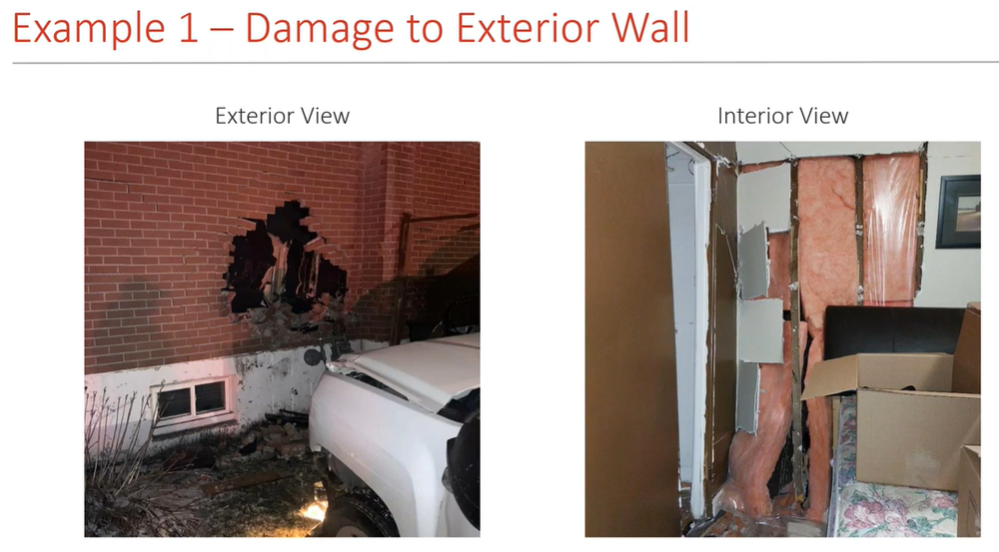
Consider the first example where a fire car hit a house’s exterior wall. In this instance, a pickup truck collided with the insured house, causing heavy structural and non-structural damage to the exterior walls. The first photos reveal that a portion of the brick veneer has completely collapsed, and the plywood sheathing behind the veneer was also heavily damaged. From the interior perspective, all walls set behind the point of impact were displaced. Notably, no temporary shoring was set up upon our arrival. Fortunately, the affected wall was not load-bearing, so shoring was not necessary in this case.

Example number two presents another scenario where a vehicle collided with a house. From the outside, it initially appeared that the damage was mainly to the brick veneer. However, upon entering the house, it became evident that the wall had been pushed inward. The baseboard was broken, and there were visible cracks in the wall, leading to suspicions of additional damage behind the wall finishes. Subsequent removal of the interior drywall revealed that the bottom plate was broken, and several wall studs had been displaced due to the impact. This case highlights the critical need to inspect behind finishes to assess and fully address the extent of damage.
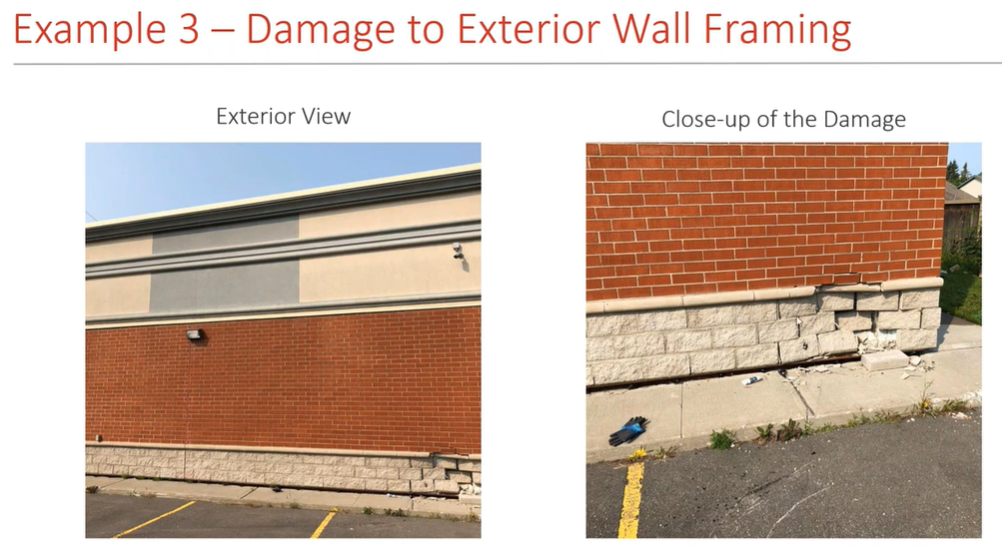
Example three illustrates a case where a car in a parking lot drove into the exterior wall of a commercial building. The impact damaged the brick veneer on the exterior wall. Upon entering the building and inspecting the affected area, cracks were observed in the drywall, and the wall was pushed inward. Similar to the previous example, the damage was discovered in the exterior wall’s metal stud framing after removing the interior wall finishes, indicating the impact’s severity.
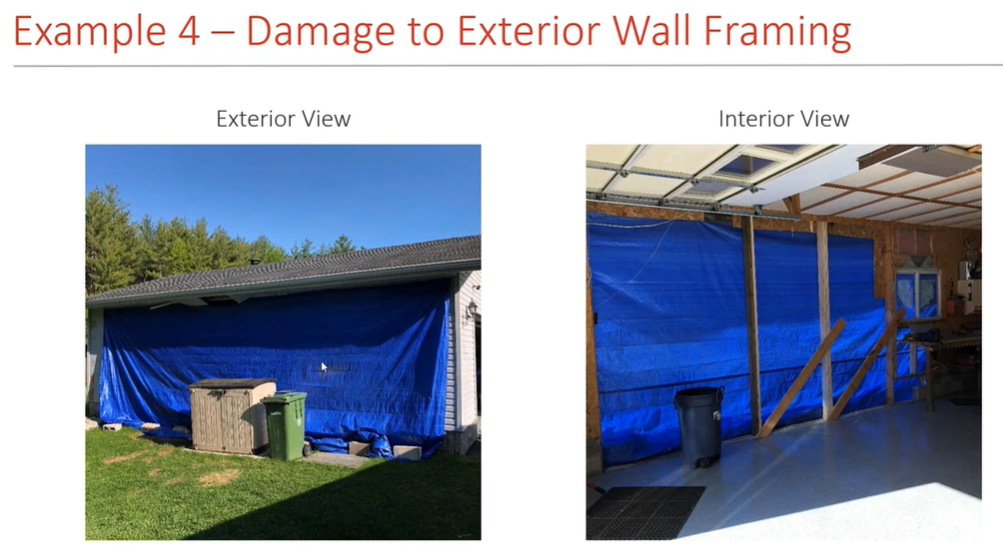
In example four, the incident involved a driver who experienced a medical emergency, leading her to drive her vehicle into the sidewall of a garage. This collision created a significant hole in the wall, destroying the wall framing. Fortunately, temporary shoring was implemented immediately. This proactive measure helped support the garage roof and prevent further structural damage.
Damage to Concrete Foundation Wall
Damage to the concrete foundation wall is another common outcome in vehicle impact building claims. This damage occurs when the wall is struck with a considerable force sufficient to break the concrete. Typical manifestations of this damage include cracks on the foundation wall, spalling of concrete on the foundation wall, and even collapse. Further details on this topic will be discussed below.

Example five presents a case of damage to the concrete foundation wall. This occurred when a vehicle ran into the south wall of an insured attached garage. From the provided photos, it is evident that the exterior of the garage wall suffered significant damage. The brick veneer and the OSB sheathing were broken, and several studs were displaced from their bases.
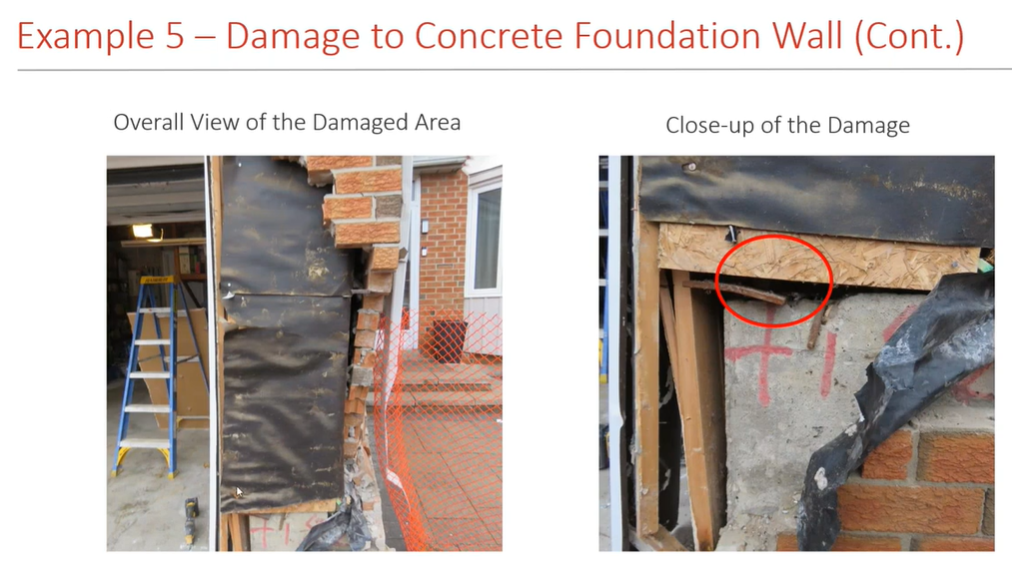
Additional photos taken at the front of the garage show that the steel posts supporting the overhead door header were displaced, and spalling was observed on the concrete foundation wall. Despite observable damage to the load-bearing wall and a load-bearing column, no temporary shoring had been set up to stabilize the structure. After our site examination, we quickly issued shoring instructions to the contractor to set up a shoring wall and shoring posts. This intervention was crucial to stabilize the structure and prevent further structural damage, which will be discussed later in the webinar.
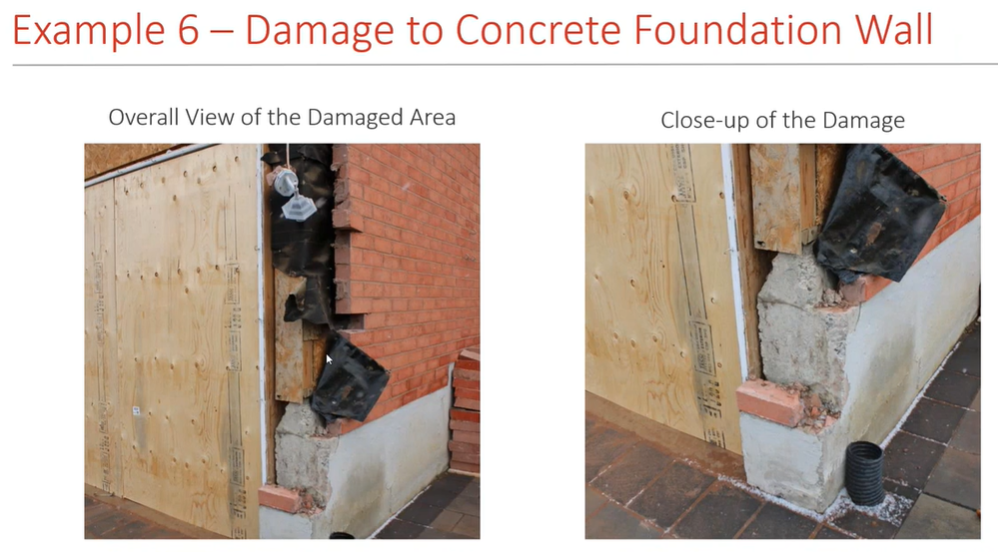
Next, we will discuss our typical shoring methods, exemplified by case number six. This is another instance of damage to the concrete foundation wall due to a vehicle impact. In this scenario, the vehicle collided directly with the insured attached garage. The effect was so significant that it damaged not only the front wall and the sidewall of the garage but also broke off part of the concrete foundation wall.
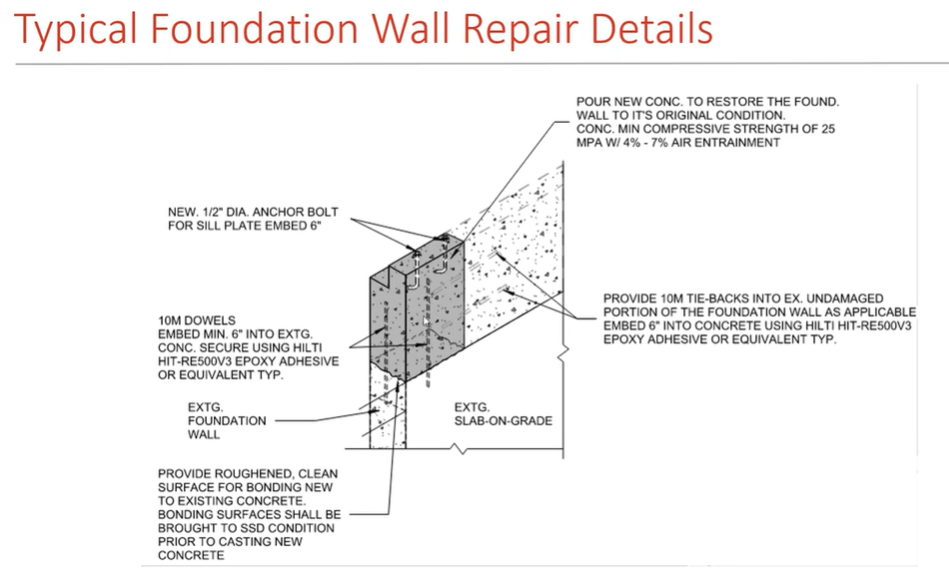
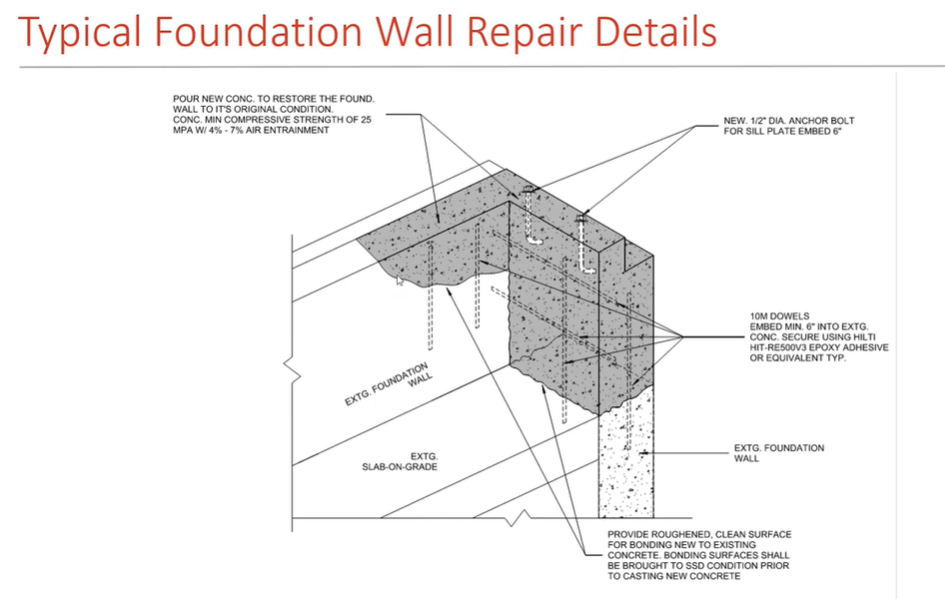
Discussing the typical repair process for damage to the concrete foundation wall involves several steps to restore the damaged area. Initially, any loose concrete on the damaged foundation wall is broken off; the surface is roughened and cleaned to prepare for bonding to new concrete. Holes are drilled into the existing concrete foundation wall, and reinforcement steel is embedded into these holes with epoxy adhesive. Finally, new concrete is poured over the existing concrete wall to restore the foundation to its original condition. The roughened surface of the existing concrete and the embedded reinforcement ensure that the new concrete adheres effectively to the existing structure.
Damage to Garage Overhead Door
The next type of damage frequently observed in vehicle impact building claims relates to the garage overhead door. Often, vehicles run into garage doors, which damages the overhead door and the frames and structures supporting it. Typical damages include harm to the overhead door, the jambs supporting the overhead door header, and the header itself.
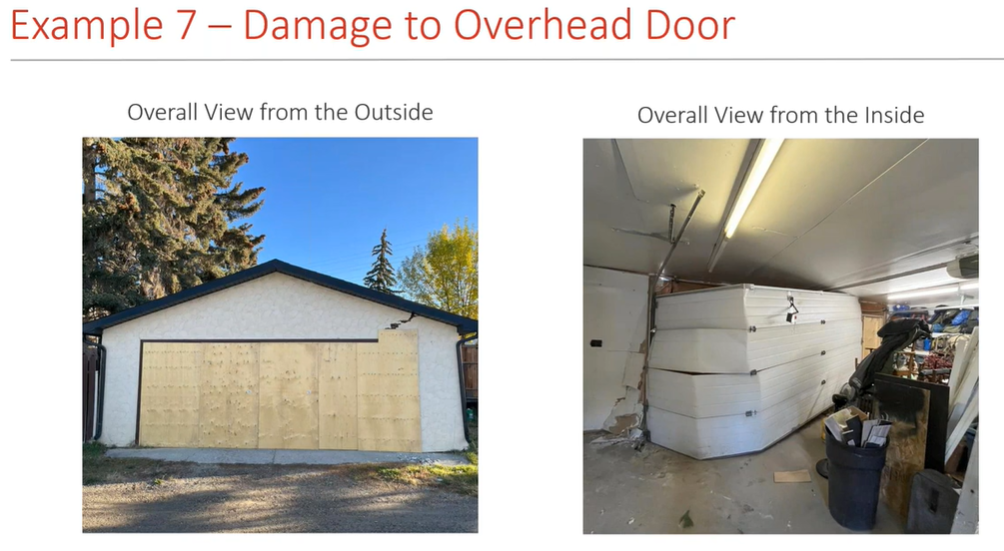
Example seven illustrates a common scenario in which a stolen car, pursued by the police, collides with the insured’s garage overhead door. After the collision, the contractor boarded off the garage opening and set up a shoring wall behind the plywood panel to support the overhead door before examination. A second photo reveals that the door was utterly deformed and pushed inward, with heavy damage visible to the exterior wall adjacent to the garage door.
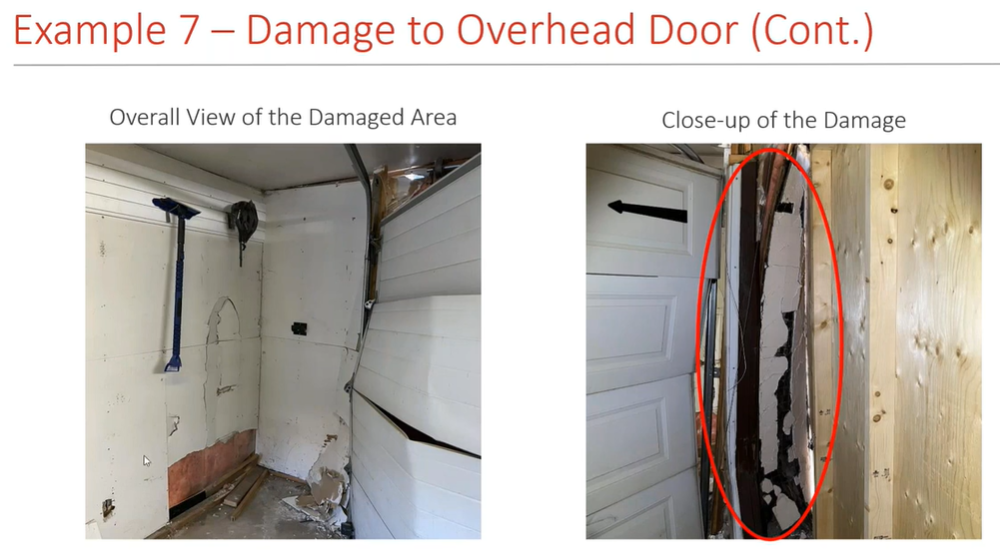
Upon inspecting the area between the garage door and the plywood panels, it was discovered that the jack and king studs supporting one side of the header were severely damaged. While the contractor had effectively set up shoring for the overhead door header, they overlooked the heavily damaged load-bearing wall adjacent to this setup. Following the on-site examination, quick action was taken to issue shoring instructions to the contractor, directing them to establish a shoring wall along this compromised wall to ensure structural stability and safety.
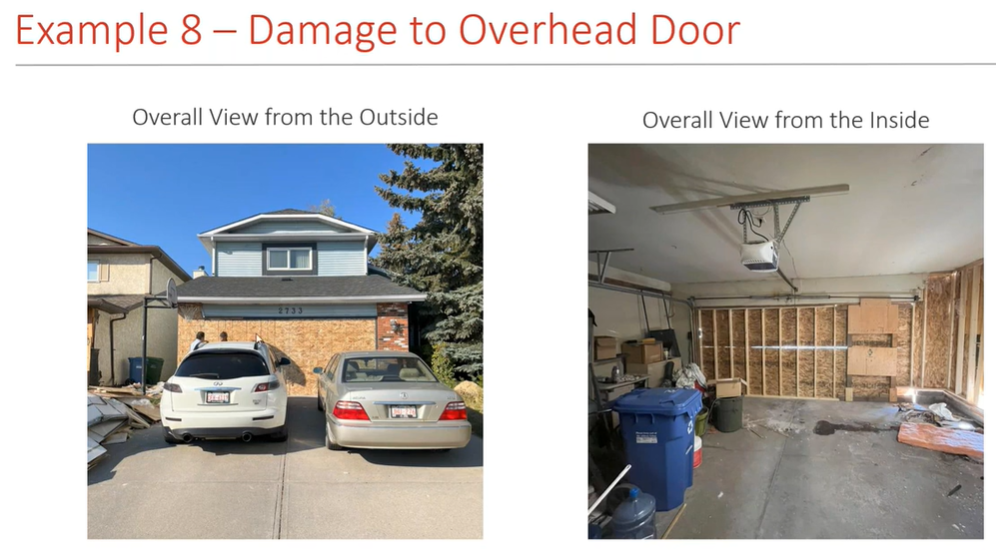
Example number eight involves a scenario where a car struck the garage door of an insured’s attached garage. The impact was so severe that it completely knocked off the garage door. Subsequently, the fire department secured the garage opening by boarding it up and setting up a temporary shoring system. This setup was intended to support the overhead door header and the damaged exterior walls before our examination, ensuring structural integrity and safety.
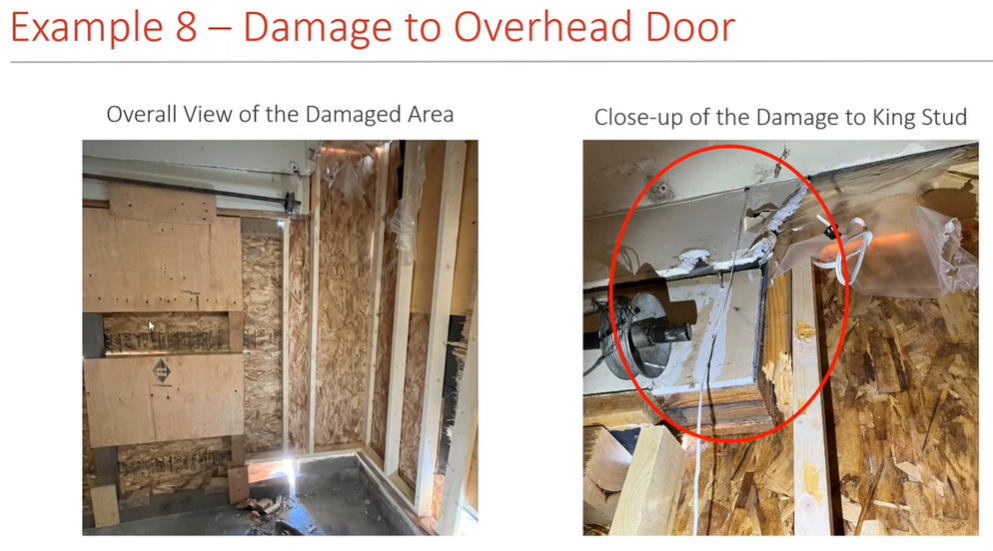
The fire department did an excellent job on this case by promptly installing temporary shoring and stabilizing the garage structure before our arrival. Upon arrival, it was evident that several walls and the bottom plate were significantly damaged. The tracks and the king stud supporting the overhead door header were completely knocked off. This incident is another typical example of a vehicle collision affecting the garage overhead door of a house, destroying both the door and its supporting structure.
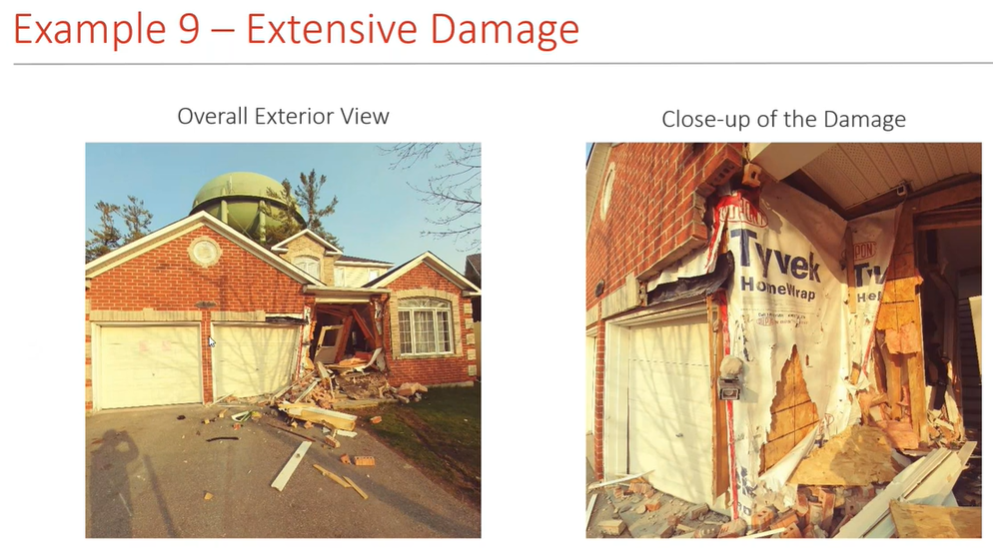
Example nine features a dramatic scenario where the police pursued a woman who had stolen a truck. She devised a plan to drive the truck through a house in an attempt to escape. Despite the audacious strategy, the outcome did not align with her expectations. As a result of this reckless maneuver, the house incurred extensive structural damage.
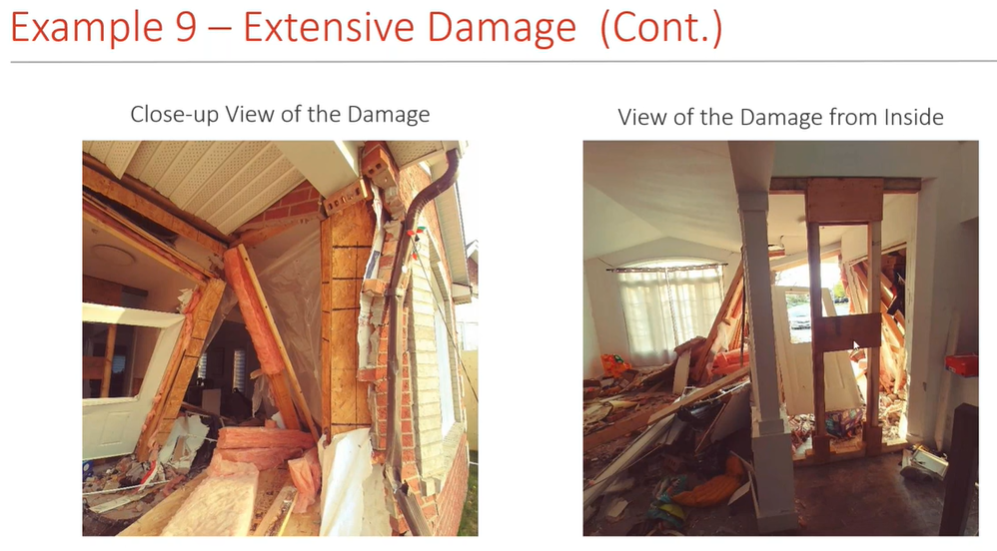
As illustrated in the photo, one of the garage sidewalls was severely displaced, and the front porch was on the verge of collapse. Damage extended to the structure inside the house as well. Consequently, the fire department had to install temporary shoring systems at several locations to stabilize the house’s structure and prevent further deterioration.
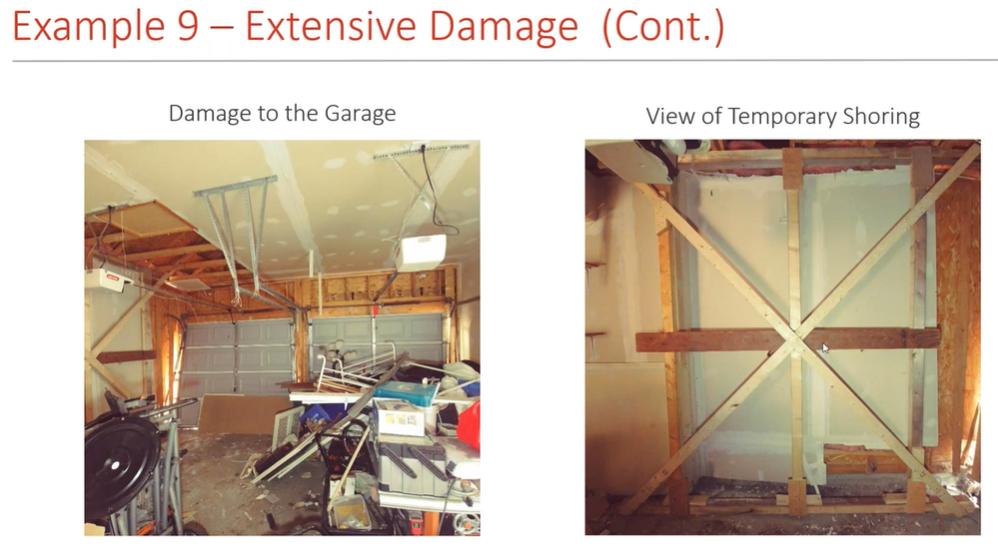
This example vividly demonstrates the severe damage that can occur to a building when it is struck by a vehicle travelling at high speed. The structural integrity can be significantly compromised, leading to extensive and potentially hazardous conditions.
Other Miscellaneous Damage
Besides the common types of damage previously mentioned, other forms have been observed, including damage to masonry walls, canopies, signage, and retaining walls. In the following sections, several examples will be provided to illustrate these various types of damage.
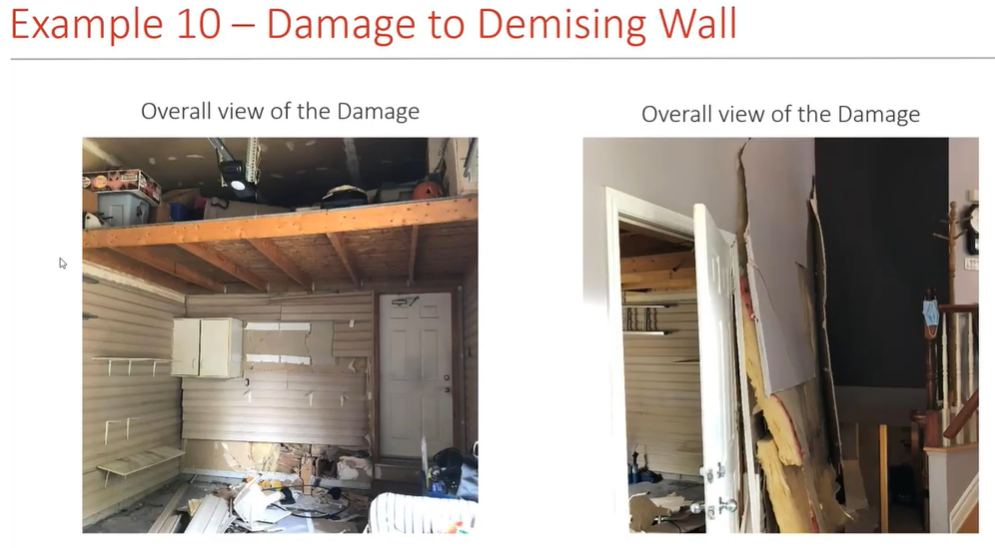
Example ten illustrates the damage caused by a vehicle impact to the demising wall, which separates the attached garage from the house’s main living space. The effect resulted in heavy damage to this demising wall, which also served as a load-bearing wall supporting the loft level above the garage. Given the structural importance of this wall, shoring should have been installed, or the loft should have been removed to ensure the safety of the occupants.
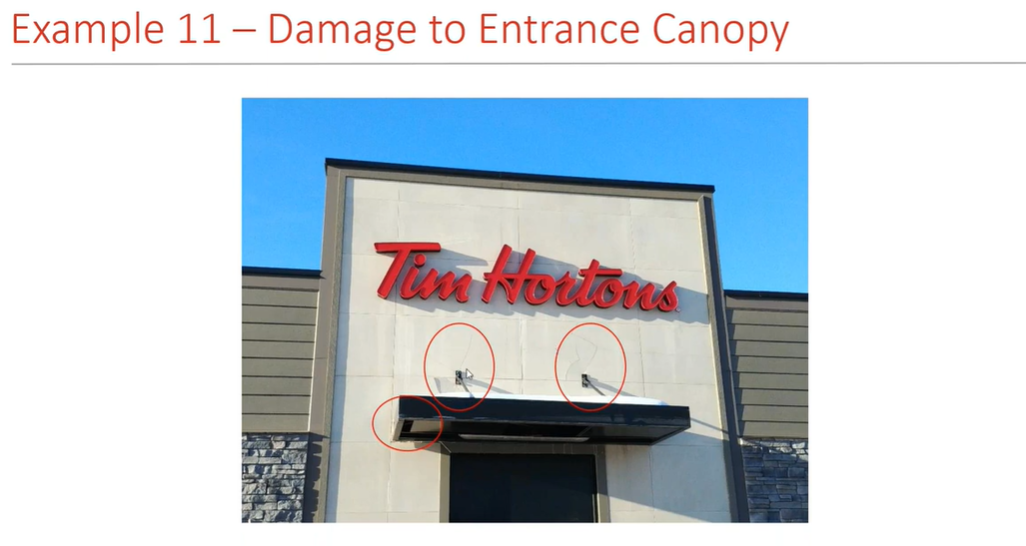
In this example, the vehicle struck the exterior canopy of a Tim Hortons. At first glance, the photo may suggest only minor damage to the wall’s exterior finishes. However, this situation requires caution because there could be structural damage behind these finishes that aren’t immediately apparent until the wall is opened. Further discussion on hidden damage and its implications will be covered later in the webinar.
Structural Concerns Post-Impact
The following discussion will focus on structural concerns following a vehicle impact. It is essential to quickly determine if load-bearing elements are damaged and to involve a structural engineer early. If load-bearing elements are compromised, prompt setup of temporary shoring is crucial.
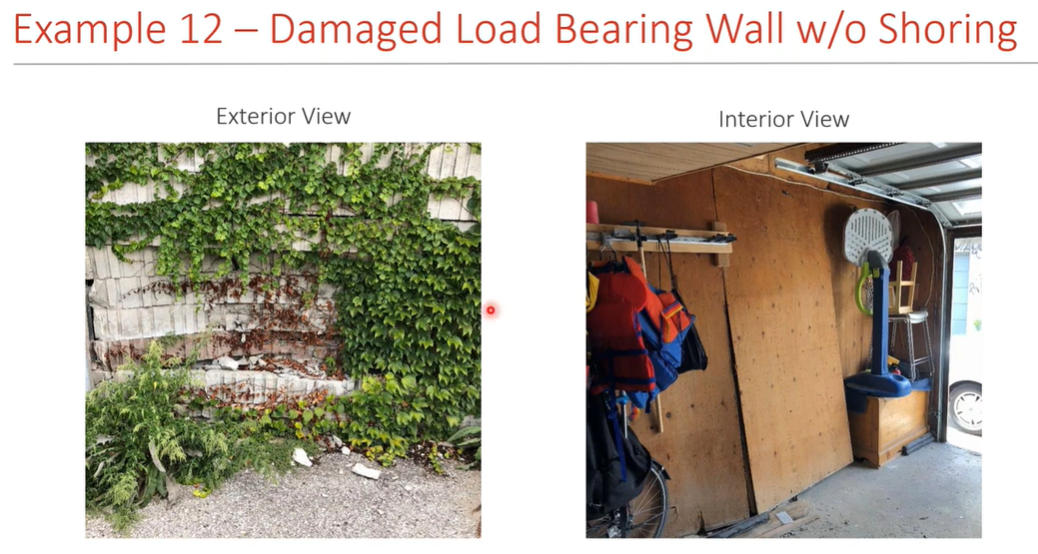
This section highlights some examples of damage to walls, specifically focusing on an exterior view of the attached garage of a house. The garage was adjacent to a public parking area where a vehicle collided with and damaged the exterior wall of the attached garage. Upon attending the site, it was noted that the finishes had yet to be removed, and the wall in question was load-bearing. Immediate instructions were sent out to put up shoring, given the wall’s critical role in supporting the roof trusses of the garage. Identifying and securing load-bearing elements like this wall is crucial, particularly if damaged, as shoring needs to be installed without delay. In complicated shoring cases, immediate contact and instructions are available to ensure timely and effective stabilization. Another incident involved a vehicle impacting a wall and some of the finishes.
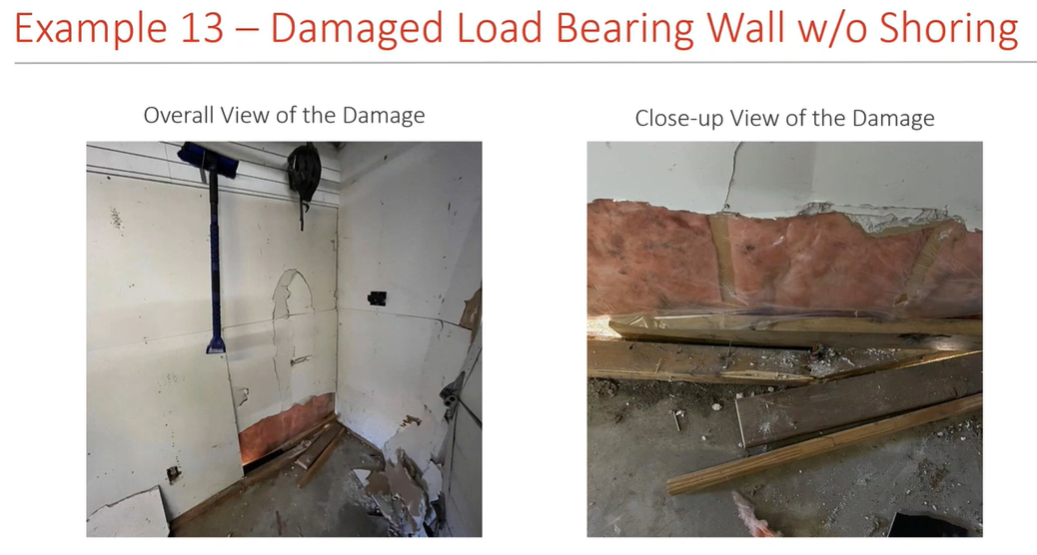
Upon closer examination of the wall, it was discovered that the bottom plate had shifted, and the studs had also shifted downward and outward, resulting in the entire fence tilting. This created a precarious situation, highlighting the importance of thorough inspections and immediate corrective actions in such scenarios.
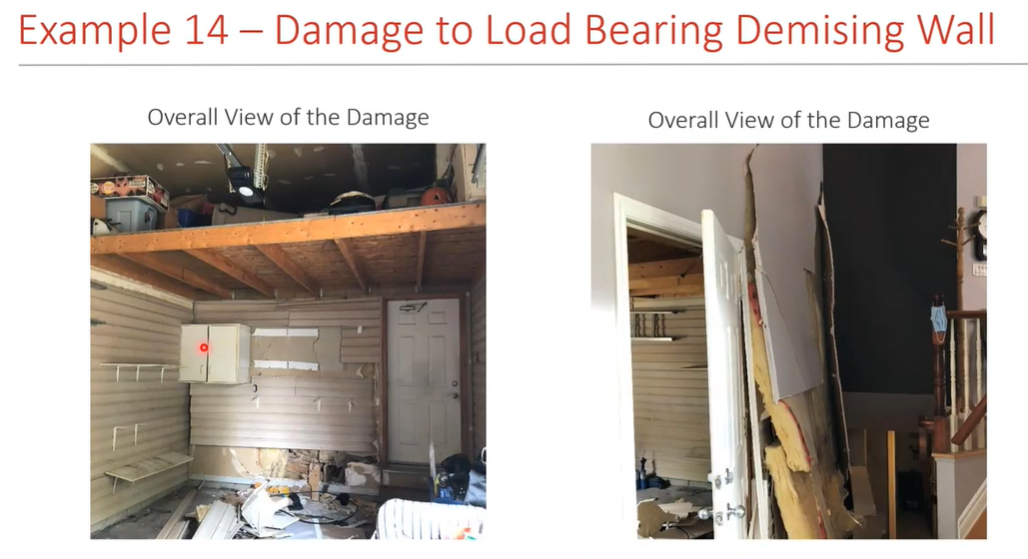
A more severe case occurred when a driver mistakenly pressed the gas pedal instead of the brake, resulting in the vehicle colliding with the demising wall between the house and the garage. This impact caused severe damage to the studs on the sides of the wall, as can be observed closely in the provided details.
The damage extended to the floor joists and the wall studs, which were broken, indicating that this wall was a load-bearing wall. In such situations, the contractor must set up shoring immediately, and assistance is available if they need instructions on how to proceed.
Now, discussing typical shoring details for commonly damaged parts of the structure, the focus is on garage door shoring, which is a frequent necessity. This shoring occurs almost 80 percent of the time when a vehicle is impacted near the garage door. It’s essential to place wood or steel shoring posts at most 12 inches from the ends of masonry lintels and wood header beams to ensure stability and safety.
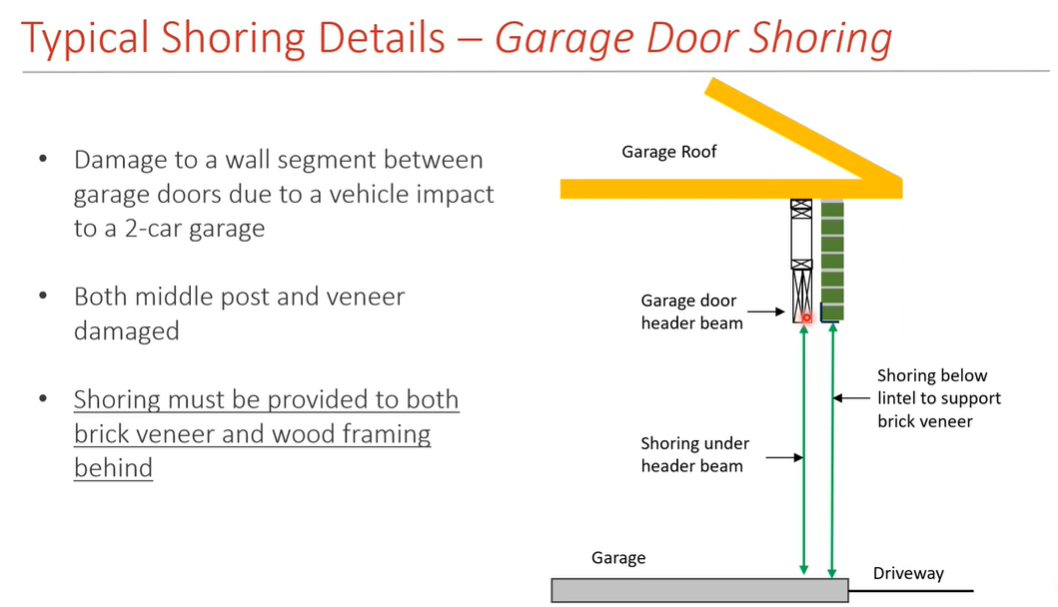
The brick veneer is often overlooked when shoring is set up underneath the header beam. It is crucial to recognize that an impact on the sidewall of the garage door can damage or shift both the brick veneer and the header beam. Therefore, it is necessary to set up shoring beneath both these elements. Specifically, when dealing with damage to the wall segments between garage doors due to vehicle impact, both the middle post and veneer are likely to be damaged, and shoring must be provided to both the brick veneer and the wood framing behind.
This is demonstrated in the section view of the garage, focusing on the sidewall, where vehicles frequently collide. If this wall is load-bearing, erecting shoring walls with a minimal offset, ideally no more than 24 inches from the wall, is advisable. This approach helps minimize the cantilever effect on the floor joists. An offset exceeding 24 inches increases the risk of floor joists deflecting, leading to cracks in the upper floors—something that must be avoided to prevent further damage extending to the upper levels of the structure. This situation exemplifies the importance of proper shoring setup to maintain structural integrity and safety.
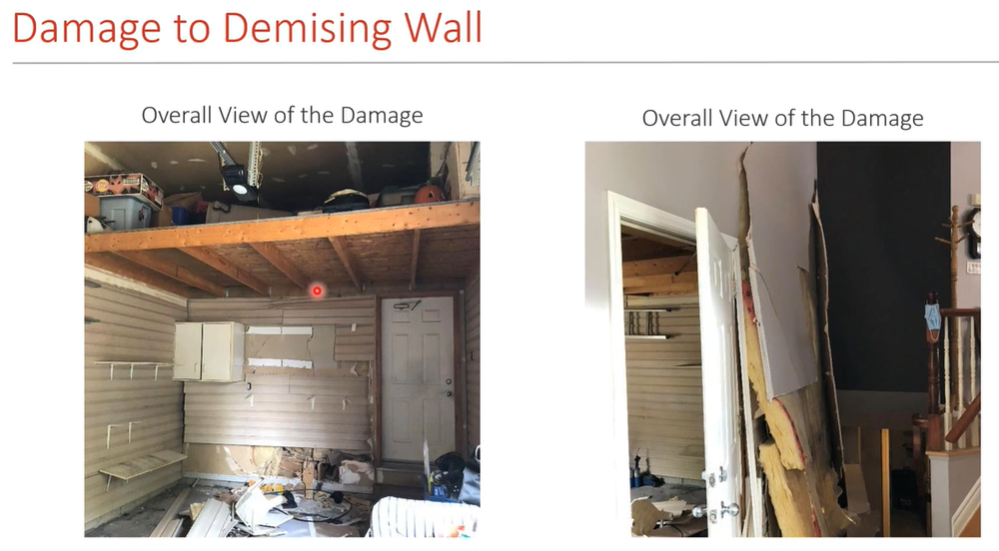
When a vehicle hits a demising wall, it is crucial to immediately install a shoring wall directly beneath the floor joists to support them and prevent further damage. Another common scenario involves a vehicle impacting a masonry wall of a garage that shares a wall with an attached dwelling. In such cases, setting up shoring is necessary, but often, only the masonry above the impact area is supported. This setup can hinder repair efforts due to limited working space.
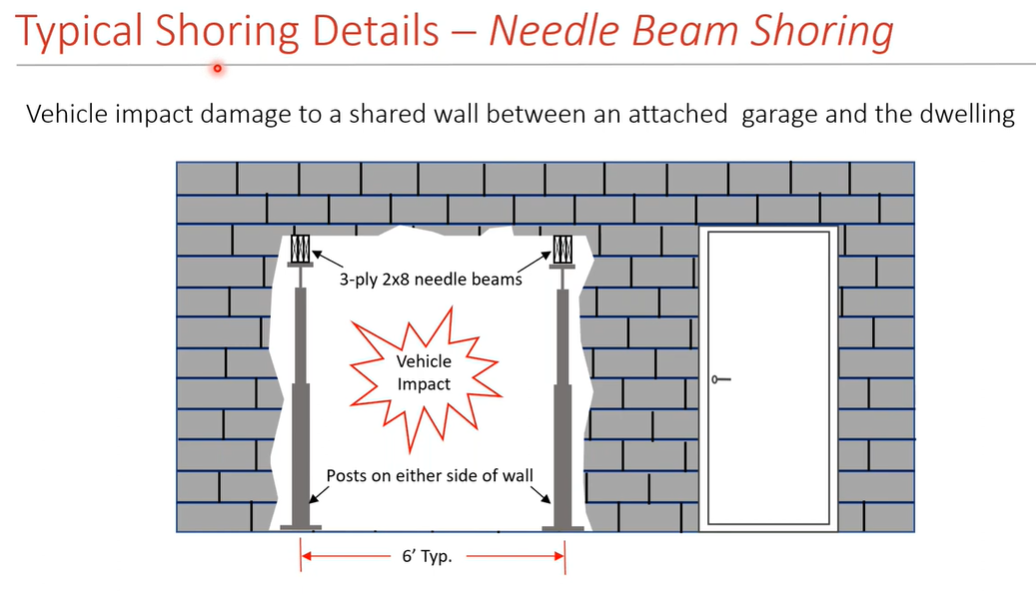
The recommended approach is to install shoring posts and place a needle beam—precisely a three-ply two, two-by-eight needle beam—across the wall. Shoring posts should be spaced no more than four feet apart to support the damaged section adequately. When setting up shoring, placing a pair of shoring posts at each end of the impact area is advisable, ensuring that the distance between the shoring posts along the wall does not exceed six feet. This setup helps ensure structural stability while providing enough space for repairs.
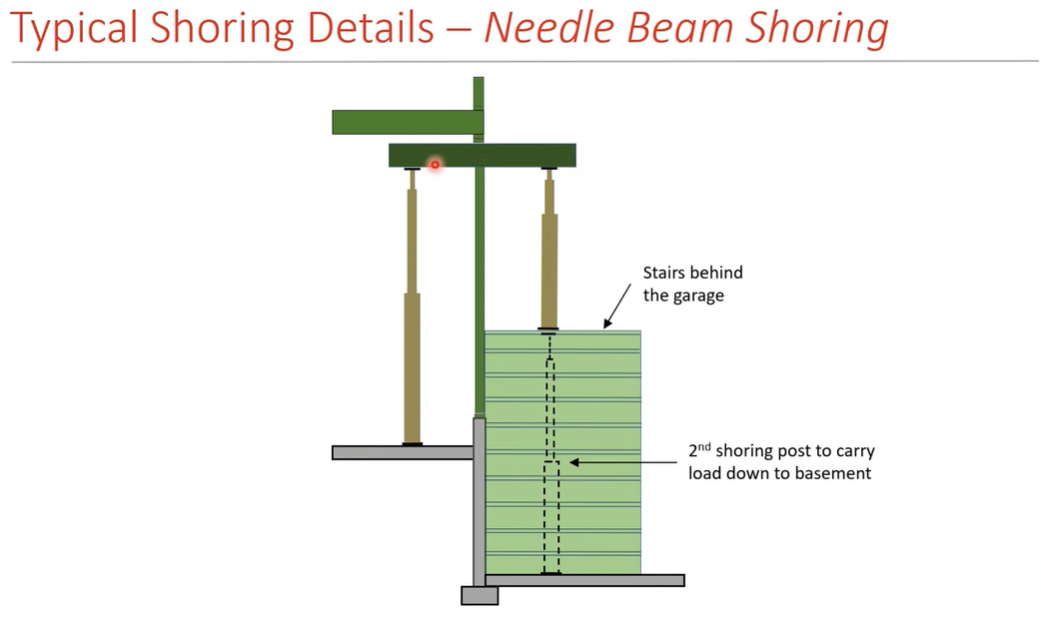
An essential aspect of setting up shoring posts is ensuring they have a continuous load path to a reliable support base, such as the foundation, a concrete slab, or the ground. This provides the stability and effectiveness of the shoring system.
Illustrating with a section view: on the right side, there is a basement, and on the left, the garage slab, along with the needle beam. The shoring post on the left is securely anchored, extending down to the garage slab, which is safe and stable. However, suppose the shoring post on the right terminates at the stairs. In that case, an additional shoring post should be installed beneath the stairs to extend it continuously to the basement’s concrete slab. This arrangement ensures that the shoring system is robust and effective, providing necessary support where structural integrity is compromised, potentially due to hidden damage.
Hidden Structural Damage Behind Finishes
Hidden structural damage is often concealed behind finishes, making it imperative to remove damaged finishes before conducting a structural site examination. Upon arrival at a site, efforts are made to expose as many hidden areas as possible; however, there is a limit to what can be revealed without prior removal of finishes.
It is recommended that contractors strip away all damaged or cracked finishes before the structural examination. This is crucial because such damage often indicates underlying structural issues. Removing these materials allows for thoroughly examining the scene to ensure that all incident-related damage is identified.
In the current discussion, examples show hidden damage discovered behind a wall, emphasizing the importance of thoroughly inspecting and removing finishes to assess and address all structural damage accurately.
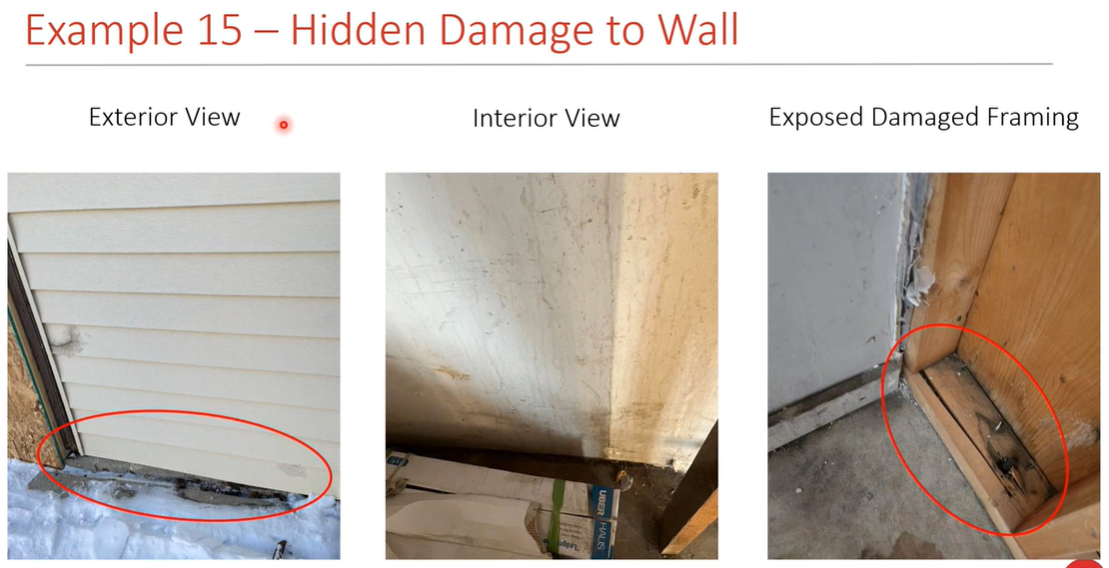
In the image on the left, we observe the exterior view of a damaged wall. From the outside, there appears to be minimal damage to the siding. However, some shifting is noticeable upon closer inspection, although it remains primarily concealed behind the finishes. Once these finishes are removed, the extent of the damage becomes apparent, particularly the damaged bottom plate of the wall, which now requires repair or replacement. This scenario represents an extreme case of hidden damage, highlighting the importance of thorough examination beyond superficial appearances to address all structural damages adequately.
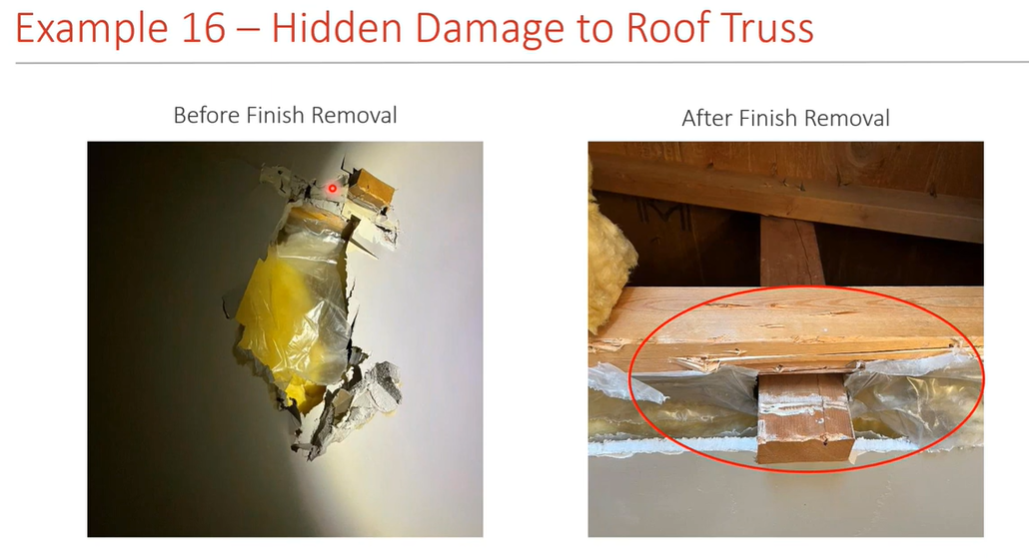
Visible cracking in the garage ceiling hints at underlying issues. Upon removal of the ceiling chips and boards, it becomes evident that the web of the roof trusses had punched through the ceiling. The car impacted the garage door track connected to the framing in this case. The force exerted by the vehicle pulled down the web of the roof truss, illustrating the connectivity and potential vulnerabilities in structural elements.
In another example, damage to exterior wall framing often occurs alongside damage to brick veneer or stone veneer. This highlights the interconnectedness of the various structural components and the cascading effects that damage to one element can have on others.
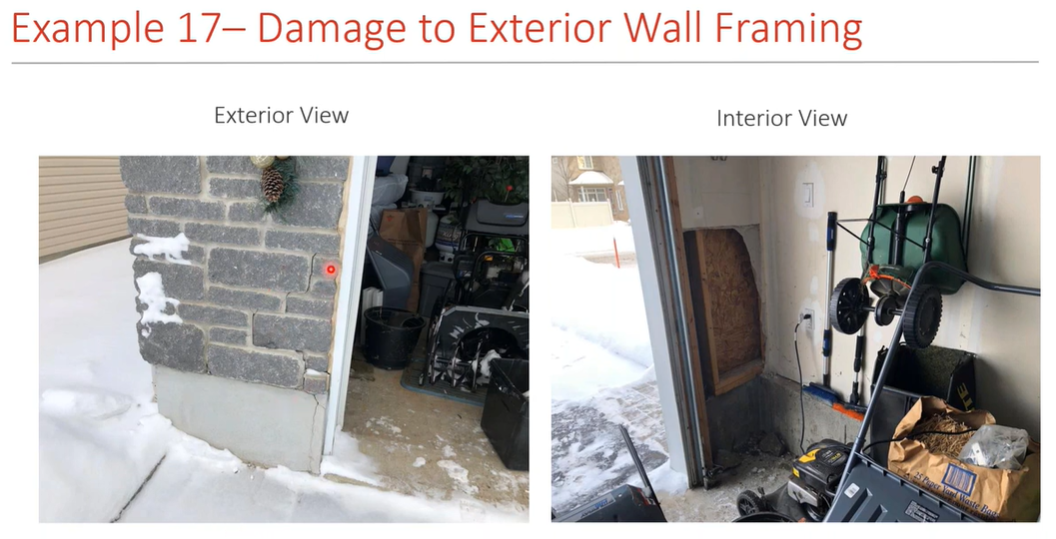
When masonry veneers, such as brick or stone, get damaged, the wall or wood framing behind it is likely affected. The veneer is typically tied to the backup wall with metal ties. In the image, you can observe the exterior view of the masonry veneer beside the garage door, showing some cracks. However, the interior view reveals almost no visible damage.
Importantly, there is a steel post located right by the garage door. A closer examination of this steel post reveals that it has shifted. In this instance, the shift was only one and a half inches, but even such a small displacement could lead to more serious structural issues. This example underscores the need to assess the visible damage and the structural components that might be affected by such impacts.
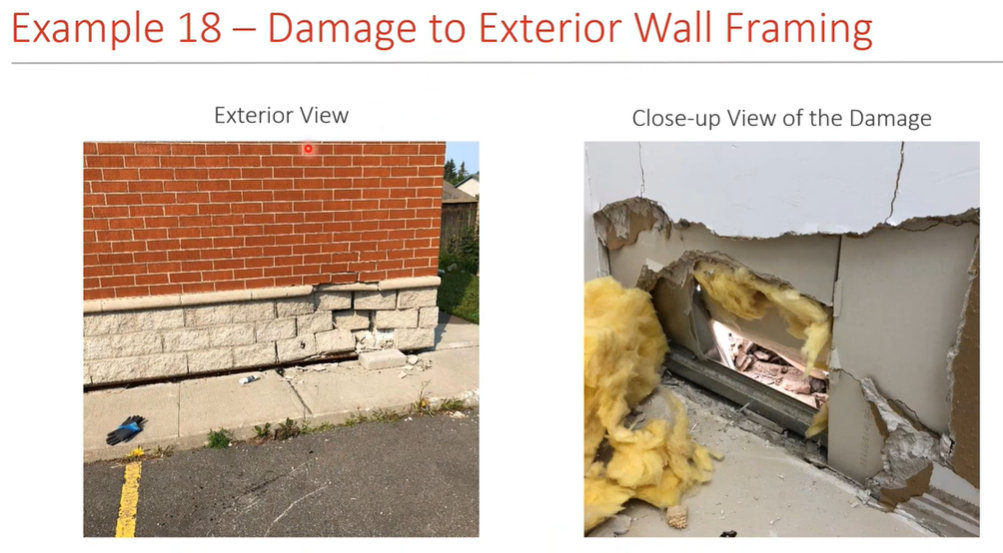
In another example, damage to the exterior wall framing of a meat shop is discussed. From the exterior, the damage appeared limited to the stone veneer and brick veneer. However, upon removing the interior finishes for a closer inspection, damage to the metal studs behind the wall finishes was discovered. As a result, for repair purposes, it was necessary to completely open up the finishes on the inside of the wall and either replace or add new metal studs to ensure the wall’s structural integrity. This example highlights the importance of thorough inspections and the potential need for extensive repairs, even if initial external damage seems minor.
Unrelated Damage Claim
In instances of unrelated damage claims, people often become more attentive to all the small cracks in and around the house after an impact. While it’s natural for impact energy to radiate from the site of the collision, causing some changes, cracks on the far side of the house are likely not related to the impact. Clients sometimes enter a heightened awareness mode post-impact, attributing all observed cracks to the vehicle impact. However, upon investigation, it frequently turns out this is different.
For example, in one case, the overall view of the wall from the outside showed some cracks on the far side, away from the impact site. The property owner claimed the vehicle impact caused these. Yet, the cracks were located far from where the vehicle struck, and signs of previous repairs suggested these were pre-existing conditions. Moreover, an internal inspection revealed no cracks in the interior finishes, supporting the conclusion that these cracks were unrelated to the impact.
Another example involves a house where a vehicle hit an exterior wall, shifting some studs. The contractor repositioned and secured the studs, but cracks were noticed in the foundation wall. The homeowner claimed these resulted from the vehicle impact. However, the nature of the effects and a slight curb suggested that if the impact had been severe enough to cause the cracks, the vehicle would have caused more noticeable damage to the wall. Google Maps imagery was consulted to support the assessment further, confirming that these cracks were pre-existing. This reinforces the importance of comprehensive evaluations distinguishing between related and unrelated damages following an impact.
How OCI Structural Engineers Can Assist You With Your Claims
At OCI, our typical scope of work for vehicle-impacting building claims includes assessing the damage caused by the vehicle and providing a detailed written report of all findings. We also comment on the safety of the affected property and, if required, provide shoring instructions, especially in cases of severe impact.
An example of our involvement is evident in a case where a driver, due to a medical condition, accidentally pressed the gas pedal instead of the brake, leading the vehicle to crash through the exterior wall of a garage and continue moving inside. In this instance, the contractor set up the shoring quickly and effectively. Still, we remained available to offer additional guidance on handling complex and severe structural damage—this case involved damage to the garage’s corner, complicating the car’s removal. We had to design shoring around or beside the vehicle to ensure safe removal.
Furthermore, we provide essential services such as producing an accurate scope of repairs and advising on whether a building permit is necessary for the restoration work—something that is almost always required. We are prepared to apply for building permits and provide engineering drawings for the restoration work. Our team ensures that all safety and structural integrity are addressed, offering necessary support throughout restoration.
Conclusion
This article has detailed the role of structural engineers in assessing and managing vehicle-impacted building claims. Their expertise is vital in evaluating damage and overseeing repairs to ensure structural stability through shoring. We explored various damage scenarios, emphasizing the importance of distinguishing between impact-related damages and pre-existing conditions. Structural engineers ensure safety and restore integrity to damaged structures, helping affected individuals and properties recover efficiently.